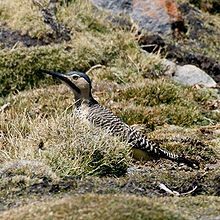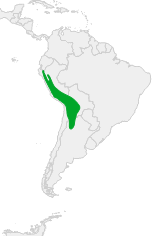Andean Flicker
Facts
Conservation Status: Least Concern
Location: Peru and the southern border region of Ecuador; also western Andean Bolivia, and northern regions of Argentina and Chile.
Lifespan: 25 to 30 years
Conservation Status: Least Concern
Location: Peru and the southern border region of Ecuador; also western Andean Bolivia, and northern regions of Argentina and Chile.
Lifespan: 25 to 30 years
Scientific Classification
Kingdom: Animalia
Phylum: Chordata
Class: Aves
Order: Piciformes
Family: Picidae
Genus: Colaptes
Species: C. rupicola
Binomial name: Colaptes Rupicola
Kingdom: Animalia
Phylum: Chordata
Class: Aves
Order: Piciformes
Family: Picidae
Genus: Colaptes
Species: C. rupicola
Binomial name: Colaptes Rupicola
Description
Height: 30cm
Other: Upperside strongly barred in dark brown/pale buff. Underside pale buff with few dark spots on the breast. Head pale buff with dark crown continuing down the rear neck, and with dark malar stripe, red in male. Bill black, eye yellow.
Height: 30cm
Other: Upperside strongly barred in dark brown/pale buff. Underside pale buff with few dark spots on the breast. Head pale buff with dark crown continuing down the rear neck, and with dark malar stripe, red in male. Bill black, eye yellow.
Behaviour
They often nest in colonies rather than solitary.
They often nest in colonies rather than solitary.
Predators or Prey?
The Andean Flicker's prey is mostly ants.
The Andean Flicker's prey is mostly ants.
Diet
The diet primarily includes ants.
The diet primarily includes ants.
Habitat
Its natural habitats are subtropical or tropical high-altitude grassland and pasture-land with cliffs or road cuts. It seldom is found below 2000m in elevation, and prefers high elevation Puna grassland habitat, and is the common flicker in the Altiplano.
Its natural habitats are subtropical or tropical high-altitude grassland and pasture-land with cliffs or road cuts. It seldom is found below 2000m in elevation, and prefers high elevation Puna grassland habitat, and is the common flicker in the Altiplano.
Conservation
The Andean Flicker's conservation status is of Least Concern. Therefore, there is not a great need to conserve this species. This is why it is rare to see Andean Flickers in captivity.
The Andean Flicker's conservation status is of Least Concern. Therefore, there is not a great need to conserve this species. This is why it is rare to see Andean Flickers in captivity.
Reproduction
It excavates its nest hole in a stream bank, cliff face or road cut. 5-9 white eggs are laid.
It excavates its nest hole in a stream bank, cliff face or road cut. 5-9 white eggs are laid.



